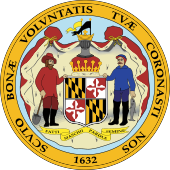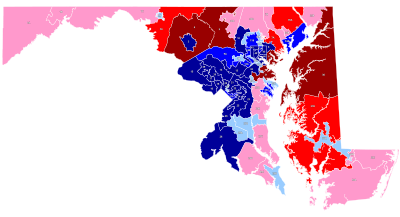Maryland House of Delegates
This article needs additional citations for verification. (September 2024) |
Maryland House of Delegates | |
|---|---|
| Maryland General Assembly | |
 | |
| Type | |
| Type | |
Term limits | None |
| History | |
New session started | January 8, 2024 |
| Leadership | |
Speaker pro tempore | |
Majority Leader | |
Minority Leader | |
| Structure | |
| Seats | 141 |
 | |
Political groups | Majority
Minority
|
Length of term | 4 years |
| Authority | Article III, Section 2, Maryland Constitution |
| Salary | $50,330/year[1] |
| Elections | |
| First past the post in single member districts; Plurality-at-large voting for multi-members districts. | |
Last election | November 8, 2022 |
Next election | November 3, 2026 |
| Redistricting | Legislative Control |
| Meeting place | |
 | |
| House of Delegates Chamber Maryland State House Annapolis, Maryland | |
| Website | |
| Maryland House of Delegates | |
The Maryland House of Delegates is the lower house of the legislature of the U.S. state of Maryland. It consists of 141 delegates elected from 47 districts. The House of Delegates Chamber is in the Maryland State House on State Circle in Annapolis. The State House also houses the Maryland State Senate and the offices of the Governor and Lieutenant Governor of the State of Maryland. Each delegate has offices in Annapolis, in the nearby Casper R. Taylor Jr. House Office Building.
History
[edit]17th century
[edit]The Maryland House of Delegates originated as the Lower House of the General Assembly of the Province of Maryland in 1650, when it was an English colony, when the Assembly (legislature) became a bicameral body.[2] The Lower House often fought with the Upper House for political influence in the colony. The Upper House consisted of the Governor and his Council, all personally appointed by Lord Baltimore and Proprietor of the Province, and thus tended to protect his interests in Maryland. Conversely, the Lower House tended to push for political change in the colony, claiming to be the true elected representatives of the people.
In this context, the Lower House continually fought for more power by asserting exclusive rights in certain legislative areas, such as levying taxes and originating money bills. This reflected similar attitudes in the other colonies on the East Coast of North America with the beginnings and growth of representative government during the 17th century, as each province's representatives constantly agitated for more rights, powers, and respect from the Proprietors, Governors, and even the King and Parliament in London.
The Governor also had some measure of control over the Lower House in the late seventeenth century. Despite the fact that each county was entitled to elect four delegates, the governor selected only two of these to sit in the Lower House. This enabled the Governor to control the Lower House's membership.
In 1689, the transfer of Maryland from a proprietary colony to a royal colony temporarily quieted the disputes between the Lower House and the Governor and Council. Appointed by the crown, the royal governors allowed the Lower House substantial latitude with its legislative agenda. The first General Assembly under Royal Authority, in 1692, passed 85 acts in a single session. The Lower House immediately acted to remove the Governor's influence over the election of delegates. Now, elected delegates could attend the session without the need for a special writ from the Governor. At the same time, standing or continuing committees were established. These eliminated the Lower House's reliance on ad hoc committees and created the first modern legislature in Maryland. During this period, the Lower House became known as the "House of Delegates".
18th century
[edit]The Maryland Constitution of 1776 formally established the modern House of Delegates. Initially, representation was based on geography as the voters of each county elected four delegates, and two each were elected from the towns of Annapolis and Baltimore.[2] These delegates served one-year terms (increased to two years in 1845, and four years in 1922, as it is today).
19th century
[edit]Beginning with the 1838 elections, each county elected at least three and up to six delegates depending on its population. Baltimore City elected the same number of delegates as did the most populous county, but after 1840, the Town of Annapolis was then considered part of Anne Arundel County. Reapportionment was required after every federal census in an attempt to achieve equal representation.
Modern era
[edit]The current pattern for distribution of seats in the House of Delegates began with the legislative apportionment plan of 1972 and has been revised every ten years thereafter. The plan created 47 legislative districts, many of which cross county boundaries to delineate districts relatively equal in population. Each legislative district sends three delegates for a total of 141 members of the House. Some of the larger districts are divided into delegate sub-districts to provide local representation to areas not large enough to constitute an entire legislative district.[2] In a special session on May 1, 2019, Delegate Adrienne A. Jones became the first woman and the first African American to be elected Speaker of the Maryland House of Delegates.[3]
Powers and functions
[edit]The powers and functions of the Maryland House of Delegates are outlined in the Maryland Constitution. Along with the State Senate, the House has the power to approve laws, establish executive departments, levy taxes, and propose state constitutional amendments. Both houses also have the power to elect the state treasurer and to appoint a new Governor if the offices of Governor and Lieutenant Governor are simultaneously vacant. In addition, the House of Delegates has the sole power to impeach members of the executive branch, including the Governor. Once the House of Delegates has passed articles of impeachment, the person impeached stands trial before the State Senate.
Organization
[edit]The House of Delegates utilizes a number of different organizational structures. Much of the work of drafting and reviewing bills is done by six standing committees: Appropriations, Economic Matters, Environment and Transportation, Health and Government Operations, Judiciary, and Ways and Means. Each of these committees is then divided further into sub-committees by issue area. An additional continuing committee, Executive Nominations, has the responsibility for confirming appointments of the Governor. Delegates also divide themselves into a variety of legally recognized work groups, Joint and Special Committees, caucuses, and geographic delegations. The two largest caucuses are those of the Democratic and Republican Parties.
Smaller caucuses might group Delegates by identity, such as the Women's Caucus,[4] notably the first women's legislative caucus founded in the United States.[5] The Asian-American and Pacific Islander caucus,[6] or Legislative Black Caucus are other examples. Delegates may also organize by issue or area of experience, such as the Veterans' Caucus.[7] In addition, delegates from a certain county, smaller towns, or Baltimore City might organize its delegate delegation into a caucus-style group, such as the Baltimore City Delegation or the Western Maryland Delegation.
Composition
[edit]
| 3 sub-districts | 2 sub-districts | 1 sub-district |
|---|---|---|
| 3 dem. 2 dem., 1 rep. 1 dem., 2 rep. 3 rep. | 2 dem. 1 dem., 1 rep. 2 rep. | 1 dem. 1 rep. 1 ind. |
| Affiliation | Party (Shading indicates majority caucus)
|
Total | ||||
|---|---|---|---|---|---|---|
| Democratic | Republican | Grn | Ind | Vacant | ||
| 2007–2010 Session | 104 | 36 | 0 | 1[8] | 141 | 0 |
| 2011–2014 Session | 98 | 43 | 0 | 0 | 141 | 0 |
| 2015–2018 Session[9] | 91 | 50 | 0 | 0 | 141 | 0 |
| October 15, 2018[10] | 92 | 49 | 0 | 0 | 141 | 0 |
| November 19, 2018[11] | 91 | 49 | 1 | 0 | 141 | 0 |
| 2019–2022 Session | 99 | 42 | 0 | 0 | 141 | 0 |
| 2023–2025 Session | 102 | 39 | 0 | 0 | 141 | 0 |
| Latest voting share | 72.3% | 27.7% | ||||
Leadership
[edit]Current leadership in the Maryland House of Delegates.[12]
| Position | Name | Party | District |
|---|---|---|---|
| Speaker of the House | Democratic | 10 | |
| Speaker Pro Tempore | Democratic | 11B | |
| Majority Leader | Democratic | 20 | |
| Majority Whip | Democratic | 24 | |
| Minority Leader | Republican | 1B | |
| Minority Whip | Republican | 4 |
Committees
[edit]| Committee | Chairpersons | Subcommittees |
|---|---|---|
| Appropriations | Ben Barnes (D–College Park), Chair
Mark S. Chang (D–Glen Burnie), Vice Chair |
|
| Economic Matters | C. T. Wilson (D–White Plains), Chair
Brian M. Crosby (D–Great Mills), Vice Chair |
|
| Environment & Transportation | Marc Korman (D–Bethesda), Chair
Regina T. Boyce (D–Baltimore), Vice Chair |
|
| Health & Government Operations | Joseline Peña-Melnyk (D–College Park), Chair
Bonnie Cullison (D–Silver Spring), Vice Chair |
|
| Judiciary | Luke Clippinger (D–Baltimore), Chair
J. Sandy Bartlett (D–Laurel), Vice Chair |
|
| Rules & Executive Nominations | Anne Healey (D–Hyattsville), Chair
Marvin E. Holmes Jr. (D–Upper Marlboro), Vice Chair |
|
| Ways & Means | Vanessa Atterbeary (D–Fulton), Chair
Jheanelle Wilkins (D–Greenbelt), Vice Chair |
|
See also
[edit]References
[edit]- ^ "Report of the General Assembly Compensation Commission" (PDF). Retrieved August 22, 2019.
- ^ a b c Maryland State Archives (June 17, 2004). "Maryland House of Delegates – ORIGIN & FUNCTIONS". Retrieved June 12, 2007.
- ^ "Baltimore County Del. Adrienne Jones elected speaker of the Maryland House of Delegates". The Baltimore Sun. May 1, 2019.
- ^ "Maryland General Assembly Caucuses - Women Legislators of Maryland". msa.maryland.gov.
- ^ Maryland State archives, accessed June 30, 2017
- ^ "Maryland General Assembly Caucuses - Maryland Legislative Asian-American & Pacific-Islander Caucus". msa.maryland.gov.
- ^ "Maryland General Assembly Caucuses - Maryland Veterans Caucus". msa.maryland.gov.
- ^ For organizational purposes, the Independent caucused with the Republicans.
- ^ The Baltimore Sun (November 5, 2014). "Republicans ride GOP wave to gain General Assembly seats". Retrieved November 5, 2014.
- ^ "Anne Arundel delegate who came out as bisexual during conversion therapy debate changes parties". The Baltimore Sun. Retrieved October 15, 2018.
- ^ "OUTGOING DELEGATE SWITCHES TO GREEN PARTY". The Montgomery County Sentinel. Retrieved November 21, 2018.
- ^ Maryland Manual On-Line (March 3, 2017). "Maryland House of Delegates – Organizational Structure". Retrieved April 19, 2017.
Further reading
[edit]Legislative District Maps, which are updated every ten years

